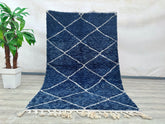What are the characteristics of a Moroccan rug?
Types of Moroccan Rugs
When you’re shopping for a Moroccan rug, it's essential to understand the types available to match your specific needs and decor.
Hanbel (Kilim)

Hanbel, or kilim rugs, are flat-woven and have no pile, making them lightweight and easy to maintain. They’re often used in warmer climates due to their easy-to-clean nature—simply shake them outside to remove dust or sand. These rugs are ideal for adding style to timber floors, serving as bed covers, or even being displayed as wall hangings. Hanbel rugs typically feature bold designs and geometric patterns, making them both decorative and functional.
Knotted Pile Rugs

Knotted pile rugs are woven with varying pile depths: low, medium, or deep pile, depending on the number of woolen knots per inch. Heavier and more luxurious, these rugs are often preferred in European homes, especially in high-traffic areas or bedrooms where comfort is a priority. Each rug is handwoven with care, offering a unique aesthetic and a cozy feel underfoot .
Boucherouite Rugs (Rag Rugs)

Made using recycled textiles like cotton scraps, wool remnants, and sometimes metallic threads, Boucherouite rugs are exceptionally hard-wearing and easy to clean. Their playful colors and patterns make them popular in kids’ rooms, kitchens, or bathrooms, where they add a touch of creativity and charm. These vibrant, eclectic rugs are a unique statement piece, ideal for those seeking something unconventional and fun.
Mixed Technique Rugs

In some regions, artisans combine various weaving techniques to create intricate designs. For example, Glaoui rugs from Taznakht incorporate elements of flat-weaving, knotted pile, and embroidery, resulting in a unique and highly collectible style. Similarly, other Moroccan tribes often blend techniques, creating intricate masterpieces that carry both functional and cultural value.
Regions and Tribal Groups in Moroccan Rug Making

Over 400 tribes in Morocco contribute to the country’s renowned rug-making tradition, each with its unique styles and techniques.
Beni Ouarain Rugs

Originating from the Beni Ouarain tribes, these rugs are easily recognizable by their ivory backgrounds and geometric diamond patterns in black or brown. Woven from undyed, soft natural wool, Beni Ouarain rugs offer a luxurious, warm feel and have gained popularity for their timeless simplicity. Due to their adaptability, they seamlessly fit into both modern and traditional spaces. However, if you’re looking for a vintage Beni Ouarain rug, be cautious and purchase only from reputable sellers, as the popularity has led to the creation of replicas.
Boujad Rugs

Boujad rugs, crafted by women in the Al Haouz plains, are known for their diversity. Traditional Boujad rugs feature geometric patterns with lozenges and borders, while other styles include checkerboards or abstract designs. Their bold colors and freeform motifs make each rug unique, blending spontaneity with artistic expression. Boujad rugs are especially treasured for their vibrant aesthetics and can serve as a dynamic centerpiece in any room.
Ait Ouaouzguite (Taznakht) Rugs

Hailing from the Ait Ouaouzguite tribe in the Jbel Siroua region, these rugs are revered for their silky wool, striking colors, and intricate designs. Often dyed with natural colors derived from saffron, henna, and indigo, Taznakht rugs are visually stunning and of high quality. Also included in this style are the Glaoui rugs, which are flat-woven with knotted embellishments, showcasing exceptional craftsmanship.
Azilal Rugs

The Azilal region, located between the High and Middle Atlas mountains, is known for its colorful, creative rugs. Originally made for personal use, Azilal rugs may feature natural white wool with contrasting black or brown patterns, or they may burst with vibrant colors and abstract designs. The expressive style and playful patterns make Azilal rugs a fantastic option for those seeking to add an artistic touch to their decor .
Ait Bou Ichaouen Rugs

The nomadic Ait Bou Ichaouen tribe, located in the remote northeastern region of Morocco, has recently gained attention for their bold and imaginative rugs. Free from outside influences, these rugs often showcase vivid colors and intricate designs stemming purely from the weaver’s creativity. Due to their rarity and originality, Ait Bou Ichaouen rugs are considered collector’s items and bring a sense of adventure to any space.
Why Buy a Moroccan Rug?
The answer is simple: Moroccan rugs are handmade from high-quality wool, feature vibrant tribal designs, and offer unmatched uniqueness. Whether you’re drawn to the bold patterns, colorful palettes, or traditional weaving techniques, each rug tells a story and brings a slice of Moroccan culture into your home.
Featured Products
169 x 251 cm = 5.5 x 8.2 ft moroccan wool rug, moroccan style rug, bohemian rug, handmade rug, outdoor patio, beniourain Rug, decor rug, Handmade Gift
- $599.00
$1,830.00- $599.00
- (-67%)
- Unit price
- / per
155 x 247 cm = 5.1 x 8.1 ft Diamonds Blue Soft Dots Berber Runner Rug - Handmade Moroccan Wool, Minimalist Design, Vintage Style, Perfect for Weddings & Bohemian Decor
- $599.00
$1,830.00- $599.00
- (-67%)
- Unit price
- / per
- Authentic Moroccan rug
- Beni Ourain rug
- Beniouraincarpets
- Berber tribes
- Custom Area Rug
- Diamond patterns rug
- Handmade carpet
- Luxury home decor
- Moroccan Berber rug
- Moroccan home décor
- Moroccan rug aesthetics
- Moroccan rug buying guide
- Natural fiber rugs
- Plush area rug
- Rug craftsmanship
- Rug personalization
- Traditional rug design
- white beni ourain
- White wool rug










